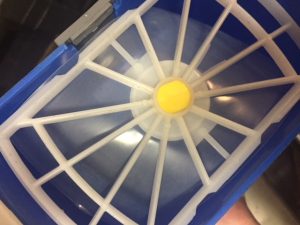A toilet siphon or toilet syphon is the component in a toilet cistern which discharges the water from the cistern into the bowl, flushing the toilet. It is normally made out of plastic.
Generally speaking, toilet cisterns operated by a flush lever will have a siphon, and cisterns operated by a button will have a flush valve. Flush valves are becoming more and more popular, especially for concealed toilet cisterns. However, siphons are much less prone to leaks.
Toilet siphon overview

Toilet siphons are usually in an inverted U-shape, with a length of pipe at one side and a bell shape at the other. Inside the bell is a piston, connected to a small metal chain or hook, or plastic link, which in turn is connected to the flush lever on the outside of the toilet cistern. The piston consists of a plastic frame, with a flexible plastic diaphragm on top.
Pushing the flush lever causes the piston to raise a body of water above the spillover point inside the siphon. From this point, it then falls down into the bowl. This initiates a siphon effect, and the rest of the water is drawn out of the cistern. The plastic diaphragm flexes out of the way to allow the water to pass.
Once the water level in the cistern falls lower than the bell of the siphon, air enters the bell. This breaks the siphon effect and completes the flush. The low water level in the cistern opens the ball valve, and the cistern fills up again for the next flush.
Variants
There are several different variants of siphon available, depending on the manufacturer. Many siphons allow you to adjust the amount of water used to flush the toilet. This is achieved via small removable plugs on the bell of the siphon. Removing the plug allows air into the bell, breaking the siphon effect. The higher up on the bell the plug is removed, the less water is used to flush the toilet.
Some siphons may be fitted with an internal overflow. This means that, should the ball valve fail, excess water will be discharged into the toilet bowl instead of via an external overflow pipe.
It is also possible to buy siphons where the bell and the pipe component are separate parts. This makes it possible to remove the bell and piston assembly for repairs without having to unscrew and remove the whole siphon from the cistern.
Toilet siphon connections
Most toilet siphons are connected to the flush pipe or pan via a 1.5 inch BSP male thread. The siphon is secured to the cistern via a plastic nut on the outside. The presence of a washer on the nut ensures a watertight seal.
Faults
Common toilet siphon faults include a broken or disconnected chain/link between the piston and the flush lever. This will result in nothing happening when you push the lever to flush the toilet. Plus, the lever itself will feel unusually light to the touch. It’s usually possible to replace these parts without having to buy a new siphon.
Another common fault is a broken diaphragm. Cracks or perforations in the diaphragm may prevent the piston from raising water above the spillover point, making it impossible to initiate the siphon and flush the toilet. Replacement diaphragms usually cost less than the price of a cup of coffee.
Advantages
However, the traditional toilet siphon has a significant advantage over the increasingly popular flush valve: it’s much less prone to leaks. That’s because in order for water to enter the bowl, the water must be physically raised over the spillover point. In most traditional toilet cisterns with a flush lever, this isn’t possible: the water level will meet the overflow pipe first.
This is in contrast to flush valves, which do not use a siphon. Instead, they rely on a flapper or washer to stop water from leaking into the toilet bowl. In many cases, a leak will quietly run down the back of the toilet bowl until you notice the toilet constantly running. This will have an impact on your water bill if you are on a meter.